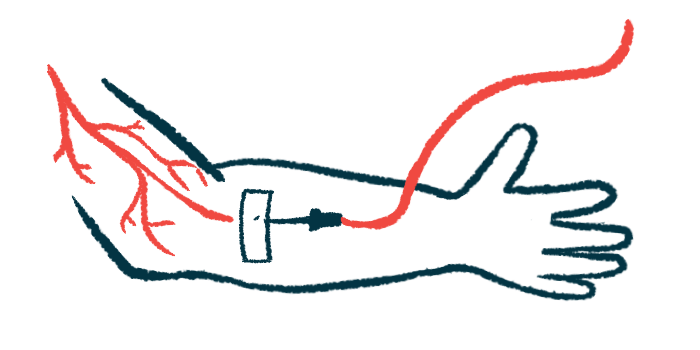Off-label Use of HAE Treatments Common, but Could Be Costly: Study
French researchers recommend 'rigorous' process to avoid overprescribing

Off-label prescription of certain medications indicated for hereditary angioedema (HAE) with C1 deficiency to people with other types of angioedema is common, a team of French researchers found.
Fewer than 20% of prescriptions for these medications, namely Berinert, Cinryze, Ruconest (conestat alfa), and Firazyr (icatibant), were for HAE patients with C1 deficiency in the team’s clinic. While such off-label use was not associated with any adverse events, inappropriate or overprescribing of these expensive medications could have a substantial financial impact.
These findings were detailed in the study “Large Predominance of Off-Label Prescriptions of C1-Inhibitor Concentrates and Icatibant in a Real-Life Setting: A Retrospective Clinical Study,” published in The Journal of Clinical Pharmacology.
Several medications are approved for the treatment of HAE associated with a deficiency in the C1 inhibitor protein. This deficiency leads to the overproduction of a molecule called bradykinin, which mediates angioedema’s characteristic swelling attacks.
These medications act by replenishing C1 inhibitor levels, as is the case with Berinert, Cinryze, and Ruconest, or by blocking the receptors that bradykinin acts on, as with Firazyr.
While the underlying mechanisms of other angioedema types differ, the clinical presentation is often similar. Thus, HAE medications are sometimes used off-label to treat these patients. In France, experts recommend off-label use in some situations.
Given the potential risks and costs associated with off-label prescribing, the research team aimed to better understand how and why these medications are prescribed to non-HAE patients in their clinic at the University Hospital of Angers, France.
Off-label prescription use
To that end, they evaluated prescriptions of the four medications filed between January 2016 and December 2020. In total, 73 prescriptions from 43 patients were analyzed.
Firazyr was the most commonly prescribed medication (40 prescriptions), followed by Berinert and Cinryze (16 prescriptions each) and Ruconest (one prescription).
Prescriptions were made to treat acute swelling attacks in 89% of the cases (65 prescriptions). Of them, 34 were filed for a standard acute attack and 31 for a conditional acute attack, meaning they were prescribed before a high-risk event, like surgery, in case they would be needed. The remaining eight were made for short-term prophylactic, or preventive, use.
In total, HAE accounted for fewer than 20% of all prescriptions. Most other prescriptions were for angioedema associated with the use of angiotensin-converting enzyme inhibitors (ACEi-related; 31.5%) or angioedema of undetermined cause (28.7%). ACEis are medications commonly prescribed to lower blood pressure that can trigger angioedema in some people.
Evidence of consultation with a pharmacist for off-label prescribing was rare, the researchers noted.
Overall, this means that 17.8% of prescriptions were on-label, as indicated by the European Medicines Agency. But most others were consistent with French recommendations, with 78.1% deemed appropriate based on these guidelines.
Eight acute prescriptions and four each of conditional and prophylactic ones were deemed “inappropriate” based on the indication they were used for.
No route of administration or dosing errors were identified, but an extra vial of Firazyr was prescribed in one case. No adverse events or deaths were reported, suggesting that improper management did not contribute to poor outcomes.
However, “the predominance of unapproved indications in prescribing these expensive drugs raises some concerns,” the researchers wrote.
When accounting for most of the cases deemed “inappropriate” and the extra prescribed bottle, researchers determined this amounted to a maximum direct extra cost of €18,228 (about $18,417 today) over a five-year period, corresponding to 13% of the overall five-year expenditure for all 73 prescriptions.
Notably, the fact that a prescription was issued doesn’t necessarily mean the medication was used, especially in conditional attack cases. Records showed that unused medication vials were returned to the pharmacy only in about a quarter of cases.
“This raises the question of whether some of these prescriptions were overprescribed and what happened to those vials that were not administered,” the researchers wrote.
Unreturned medications not known to be used could lead to a further 25.9% increase in potential maximum excess costs, the team noted.
Given their findings, the team reported they plan to develop an algorithm for clinicians to use to help determine appropriate treatment and avoid unnecessary costs. It will help define when other medications, like epinephrine, might be more appropriate as a first-line treatment and also help track unused vials.
Important to note is that treatment of non-hereditary angioedema “can only be off label, as no drug … has ever been approved in this indication,” the researchers wrote. They noted that to date, approvals for these indications in Europe have not been sufficiently supported by clinical trials.
“In the absence of effective alternatives, physicians have no choice than to continue prescribing hereditary angioedema-specific medications whenever necessary to ensure the best possible care,” the team wrote.
“However, they should follow a rigorous prescribing process to avoid overprescribing, which could be economically detrimental to the public health system in the long run,” they added.







